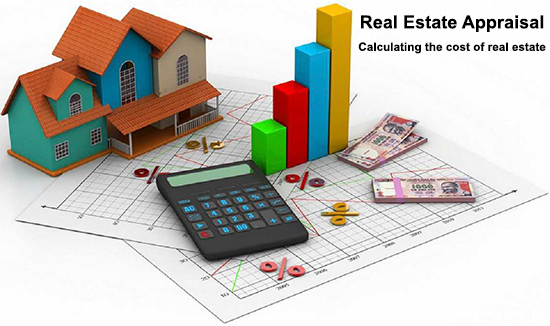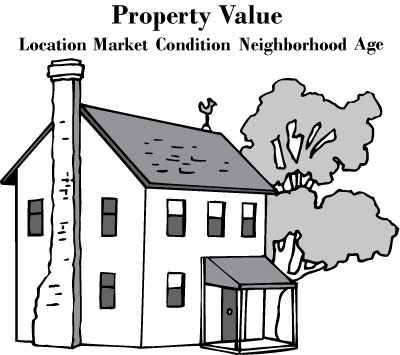There are three methods of determining the market value of real estate. These methods are the cost approach, the income approach and the sales comparison approach. For commercial property the income approach is used mostly. For residential property as homes, the sales comparison approach is used. The cost approach can be used for both commercial and residential. Those that are licensed as real estate appraisers will use at least one of these methods.
Cost Method
 This is calculated using math adding the market value of the land to the current cost to build the building as new. Then depreciation based on the age of the actual building with needed repairs or replacements also considered is subtracted from the current cost to build a like kind building. To determine land value, this requires the sales comparison approach. Here is an example of the cost appraisal method
This is calculated using math adding the market value of the land to the current cost to build the building as new. Then depreciation based on the age of the actual building with needed repairs or replacements also considered is subtracted from the current cost to build a like kind building. To determine land value, this requires the sales comparison approach. Here is an example of the cost appraisal method
- Land Value $300,000
- Cost of building $500,000
- Total value if new $800,000
- Accrued Depreciation $100,000
- Current Property Value $700,000
For the use of the cost method, the newer the building the more reliable and less challenging is this method. It can be less reliable the older the property.
Income Method
This is the method that is used the most for already rented income property. This is for both commercial, for example strip malls and residential, for example apartment buildings. With this method an accounting analysis is done with yearly revenue, also called gross income, minus operating expenses equaling net operating income. Then a capitalization rate is chosen, for example between 4% and 10%. The capitalization rate is chosen via the market of sales which have been closed with the capitalization rate determined. Also the length of the contract lease agreement is also a vital part of the capitalization rate chosen with properties with more years as part of the lease agreement having a lower capitalization rate than properties with less years as part of the lease agreement. This simply means that properties with more years as part of the contract lease agreement result in a more secure investment and have a higher property market value. Also a higher capitalization rate results in more income received from an investment in commercial or residential property. Here are some examples of the income method for determining the market value of property.
| Yearly Gross Income | Minus Yearly Gross Expenses | Equals Net Operating Income |
|---|---|---|
| $250,000 | $100,000 | $150,000 |
| Net Operating Income | Divided by Capitalization Rate | Equals Property Value |
|---|---|---|
| $150,000 | 6% | $2,500,000 |
| Net Operating Income | Divided by Capitalization Rate | Equals Property Value |
|---|---|---|
| $150,000 | 8% | $1,875,000 |
One important matter to examine. An analysis of the expenses needs to take place in order to assure that expenses have not been left out of the property income statement. A contract lease analysis is also needed to see what expenses are required to be paid by the tenant and which expenses are to be paid by the landlord or owner of the property. With some leases the tenant is required to pay for all property expenses. This is known as a triple net lease. This includes real estate property taxes, building insurance and maintenance. This is in addition to normal fees that are expected under the lease agreement such as rent, utilities, etc.
Sales Comparison Approach

This approach is primarily used for residential property used for personal and family homes. This current market value price evaluation compares a property that is being considered for possible purchase with other properties that have sold in the last 3 or 6 months. Properties that have been sold/purchased are found that have similar characteristics as the property that is being considered for a new purchase. These characteristics are features like location, number of bedrooms, bathrooms, square footage, parcel land size, and whether the house includes a garage. Also considered is the age and condition. Comparing the current property being appraised with other similar properties that have recently been purchased with an analysis of the characteristics while mixing in math calculations results in an appraised property value. Prices are adjusted to account for differences in the compared properties.
As an example of a new listed property available for purchased in a city and neighborhood. After research a similar property in the same city and a nearby neighborhood is found that has been purchased in the last 3 months. Compare the features of the property sold with the property being considered for a new sale or purchase. One of the characteristics stated above is the square footage. If the property sold for $400,000 has a square footage of 1,600. This would mean a value per square foot of $250. Comparing this is to a similar property, except with a square footage of 1,500 would mean an appraised price of $375,000.
After the analysis of the above comparing properties already sold with new properties being appraised. There are additional types of comparables and methods of recognizing values of properties in areas.
Appreciation Rates
These indicate the annual percentage increases in the market value of properties. When this is the result of a lowering of interest rates on loans for new property purchases and/or an increase in the U.S. money supply via Quantitative Easing. Then this can be seen as inflation, which has a risk of an up market with lower interest rates and a down market with higher interest rates or less available loans for new property purchases. We saw this in the year 2008.
Listing Comparables
These are properties currently on the market which are similar to the appraised property. This category can set an upper limit for the current market price of real estate unless the property is sold. This simply indicates what sellers would like to get for their properties.
Expired Comparables
These are listed properties that were listed for a long period of time, yet have never sold and closed escrow. They show a listed price value beyond the present market in terms of what buyers are willing to pay.
Pending Comparables
These are properties that have sold, but not yet closed escrow. This could show a new direction in value. For example, if previously sold comparable properties indicate a value of $500,000, while a comparable property in escrow has a sales price of $525,000, this indicates an increased price for future sold properties.
Vacancy Rates
High vacancy rates result in no current income for a number of properties. This could result in a drop in the value of property in this area. In contrast, low vacancy rates result in income for the property owners with the potential of increased profits and increased market values.

